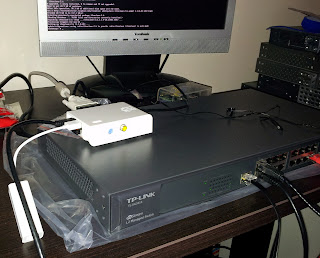Change the ComputerName value in Unattend.xml using PowerShell
A quick and dirty PowerShell script to update the value of ComputerName in Unattend.xml before imaging.
This particular value is located at:
<unattend>
<settings pass="generalize">
<component name="Microsoft-Windows-Shell-Setup" processorArchitecture="amd64" publicKeyToken="31bf3856ad364e35" language="neutral" versionScope="nonSxS" xmlns:wcm="http://schemas.microsoft.com/WMIConfig/2002/State" xmlns:xsi="http://www.w3.org/2001/XMLSchema-instance">
<computername>
Which is a bit of a mouthful, but we can be lazy and just pull the value from the nth component node (in my case it's 3, or the 4th component node). PowerShell uses dots to describe the hierarchical path, which looks a lot neater than the above:
$xml.unattend.settings.component[3].computername
To repeat, the value of .component[n] will change depending on the structure of the file.
The value of the computername node can be changed by just providing the new value:
$xml.unattend.settings.component[3].computername = "$computerName"
The imported XML then needs to be saved back to the file on disk:
$xml.save("$unattendFile")
This particular value is located at:
<unattend>
<settings pass="generalize">
<component name="Microsoft-Windows-Shell-Setup" processorArchitecture="amd64" publicKeyToken="31bf3856ad364e35" language="neutral" versionScope="nonSxS" xmlns:wcm="http://schemas.microsoft.com/WMIConfig/2002/State" xmlns:xsi="http://www.w3.org/2001/XMLSchema-instance">
<computername>
Which is a bit of a mouthful, but we can be lazy and just pull the value from the nth component node (in my case it's 3, or the 4th component node). PowerShell uses dots to describe the hierarchical path, which looks a lot neater than the above:
$xml.unattend.settings.component[3].computername
To repeat, the value of .component[n] will change depending on the structure of the file.
The value of the computername node can be changed by just providing the new value:
$xml.unattend.settings.component[3].computername = "$computerName"
The imported XML then needs to be saved back to the file on disk:
$xml.save("$unattendFile")
1: param(
2: [parameter(Mandatory = $true)]
3: [ValidateNotNullOrEmpty()]
4: [string]$computerName
5: )
6:
7: Set-ExecutionPolicy Unrestricted
8:
9: $systemDrive = $env:systemdrive
10: $unattendFile = "$systemDrive\Unattend.xml"
11:
12: [xml]$xml = get-content $unattendFile
13:
14: $currentName = $xml.unattend.settings.component[3].computername
15: write-host "Current Name: "$currentName"`n"
16:
17: $xml.unattend.settings.component[3].computername = "$computerName"
18:
19: $newName = $xml.unattend.settings.component[3].computername
20: write-host "New Name: "$newName"`n"
21:
22: $xml.save("$unattendFile")

Hello Sir,
ReplyDeletethanks for this nice article, when I execute the script i am facing a following exception, I could not figure it out, I need your kind guidance,
let me tell you the path of the Autounattend.xml file is correct and the node exists, when I execute the code it displays the existing value.
Exception setting "ComputerName": "The property 'ComputerName' cannot be found on this object. Verify that the property exists and can be set."
At line:18 char:3
+ $xml.unattend.settings.component[3].ComputerName = "$computerName" ...
+ ~~~~~~~~~~~~~~~~~~~~~~~~~~~~~~~~~~~~~~~~~~~~~~~~~~~~~~~~~~~~~~~~~~
+ CategoryInfo : NotSpecified: (:) [], SetValueInvocationException
+ FullyQualifiedErrorId : ExceptionWhenSetting
Regards
Abdul Rehman
Abdul... you may want to check to see what section the computername value is found. For me, it was component[4].
ReplyDelete